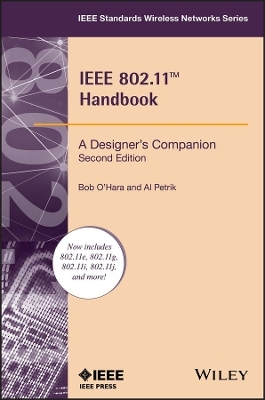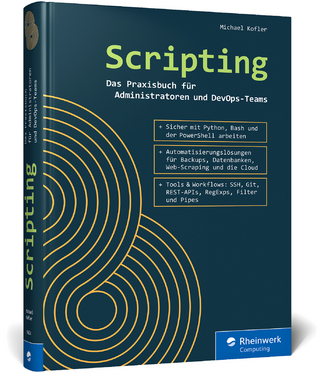
IEEE 802.11 Handbook
Standards Information Network (Verlag)
978-0-7381-4449-8 (ISBN)
Bob O'Hara is a co-founder of Airespace, a venture-funded startup company that is leading the IEEE 802.11 industry into the second stage of wireless local area network (WLAN) evolution. He is actively involved in the development of networking, telecommunications, and computing standards and products. His areas of expertise are network and communication protocols and their implementation, operating systems, system specification and integration, standards development, cryptography and its application, strategy development, and product definition. Mr. O'Hara has been involved with the development of the IEEE 802.11 WLAN standard since 1992. He was the technical editor of that standard and chairman of the revisions and regulatory extensions tasks groups. He is currently chairman of the maintenance and task group. In 2004, he was selected of one of the fifty most powerful people in networking by Network World. Al Petrick is vice president of marketing and business development at WiDeFi, a fabless semiconductor company developing 802.11 WiFi® semiconductors for the wireless consumer electronics market. Mr. Petrick's experience includes over 23 years of combined marketing and systems engineering in wireless communications and semiconductor technology. Prior to WiDeFi, he held executive management marketing and business development positions at Icefyre and Intersil. At Intersil, now Conexant, formally Harris Semiconductor, he pioneered the PRISM WLAN chipset from inception into a successful Wi-Fi product line. Mr. Petrick serves as vice chairman of the IEEE 802.11 WLAN Working Group. He has published various marketing and technical papers on wireless communications for leading wireless trade publications, marketing analysts, and financial analysts. Mr Petrick co-authored with Bob O'Hara the first edition of the IEEE 802.11 Handbook: A Designer's Companion. He serves on a number of advisory boards for Wi-Fi product companies.
Introduction xxv
Acronyms and abbreviations xxxi
Chapter 1 Similarities and differences between wireless and wired local area networks (LANs) 1
Similarities between WLANs and wired LANs 1
Differences between WLANs and wired LANs 1
Chapter 2 IEEE 802.11: First international standard for WLANs 5
IEEE 802.11 architecture 5
STA 6
Basic service set (BSS) 6
Extended service set (ESS) 8
Distribution system (DS) 9
Services 10
STA services 10
Distribution services 11
Interaction between some services 12
Summary 15
Chapter 3 Medium access control (MAC) 17
MAC functionality 17
MAC frame exchange protocol 17
Dealing with the media 18
Hidden node problem 18
Retry counters 21
Basic access mechanism 22
Timing intervals 23
Distributed coordination function (DCF) 24
Centrally controlled access mechanism (i,e„ PCF) 24
Frame formats 28
General frame format 29
Frame Control field 31
Duration/ID field 37
Address fields 37
Sequence Control field 39
Frame Body field 40
FCS field 40
Control frame subtypes 41
Request to Send (RTS) [control] frame 41
Clear to Send (CTS) [control] frame 42
Acknowledge (ACK) [control] frame 42
Power Save Poll (PS-Poll) [control] frame 44
Contention-Free End (CF-End) and CF-End plus ACK (CF-End + ACK) [control] frames 44
Data frame subtypes 45
Simple data frame 45
Data with Contention-Free Acknowledgment (Data + CF-ACK) frame 48
Data with Contention-Free Poll (Data + CF-Polt) frame 48
Data + CF-ACK + CF-Poll frame 49
Null Function (no data) frame 49
Con tent ion-Free Acknowledgment (CF-ACK) (no data) frame 49
Contention-Free Poll (CF-Poll) (no data) frame 49
CF-ACK + CF-Potl (no data) frame 50
Management frame subtypes 50
Beacon [management] frame 51
Probe Request and Probe Response [management] frames 52
Authentication [management] frame 53
Deauthentication [management] frame 54
Association Request and Association Response [management] frames 54
Reassociation Request and Reassociation Response [management] frames 54
Disassociation [management] frame 55
Announcement Traffic Indication Message (ATIM) [management] frame 55
Action [management] frame 55
Components of the management frame body 55
Fixed fields 55
Information elements 68
Other MAC operations 86
Fragmentation 86
Privacy 89
WEP details 92
Chapter 4 IEEE 802.11i security enhancements 95
Robust security network (RSN) 96
IEEE 802.1 X Authentication and Key Management Protocol (AKMP) 105
Details of IEEE 802.1X EAP AKMP operation 108
EAPOL-Key frames 109
PSK AKMP 112
Details of PSK AKMP operation 113
PMK caching 114
Preauthentication 114
Transition security networks (TSNs) 115
Confidentiality: New encryption algorithms 116
Fixing WEP: Temporal Key Integrity Protocol (TKIP) 116
TKIP operation 117
Michael MIC 120
TKIP-encrypted frame description 120
Attack countermeasures 122
New transforms 122
CCMP-encrypted frame description 124
Security management 126
Changes to existing attributes and tables 126
New attributes and tables 127
Chapter 5 IEEE P802.11e quality of service (QoS) enhancements 137
Background: What is QoS and why is QoS needed? 137
IEEE P802.1 le: What’s in and what’s out 138
The Scope of IEEE 802.11 standard 138
Mandatory and optional features 138
Limits of WLANs 138
Background of the legacy IEEE 802.11 MAC 139
Fundamentals of IEEE P802.1 le operation 140
Hybrid coordination function (HCF) 140
Enhanced distributed channel access (EDCA) 142
EDCA admission control 144
HCF controlled channel access (HCCA) 145
IEEE P802.1 le frame formats 145
New control frame subtypes 146
New data frame subtypes 148
New extensions to management frames 154
Action [management] frames 159
New information element formats 169
Optional features in IEEE P802.1 le 182
Contention-free bursts (CFBs) 182
Block acknowledgments 182
Direct link setup (DLS) 183
Automatic power save delivery (APSD) 187
IEEE P802.1 le as part of complete QoS implementation 187
Scheduling and admission control 187
Adapting to varying wireless channel conditions 188
Interface to higher layers 189
Conclusion 190
Chapter 6 IEEE 802.1 lh dynamic frequency selection (DFS) and transmit power control (TPC) 191
Users of the 5 GHz frequency 192
New parts to the IEEE 802.11 protocol 192
Transmit power control (TPC) 197
TPC operation 199
Spectrum management 200
Detection of radar operation 205
Chapter 7 IEEE 802.11d international operation 207
New roaming requirements 208
Country information element 210
International roaming with FH PHYs 212
Request information element and its protocol 214
Chapter 8 IEEE 802.1 IF Inter Access Point Protocol (IAPP) 217
Going beyond the MAC 217
More about mobility 218
Chapter 9 MAC management 221
Tools available to meet the challenges 222
Authentication 223
Association 225
Address filtering (MAC function) 227
Privacy (MAC function) 228
Power management 228
Power management in an IBSS 228
Power management in an infrastructure BSS 230
Synchronization 232
Timer synchronization in an infrastructure BSS 233
Timer synchronization in an IBSS 234
Synchronization with FH PHYs 235
Scanning 235
Joining a BSS 237
Combining management tools 237
Combining power-saving periods with scanning 237
Preauthentication 238
Areas for improvement 239
Scanning and roaming 239
Use of status and reason codes 240
Chapter 10 MAC management information base (M1B) 241
STA management attributes 241
MAC attributes 246
Chapter 11 The physical layer (PHY) 251
PHY functionality 251
Direct sequence spread spectrum (DSSS) PHY 252
DSSS PLCP sublayer 252
Data scrambling 255
DSSS modulation 255
Barker spreading method 256
DSSS operating channels and transmit power requirements 258
Frequency hopping spread spectrum (FHSS) PHY 261
FHSS PLCP sublayer 261
PSDU data whitening 264
FHSS modulation 264
FHSS channel hopping 265
Infrared (IR) PHY 267
1R PLCP sublayer 267
IR PHY modulation method 270
Geographic regulatory bodies 271
Chapter 12 PHY extensions to IEEE 802.11 273
IEEE 802.1 la: Orthogonal frequency division multiplexing (OFDM) PHY 273
OFDM PLCP sublayer 274
IEEE 802.11 a modulation 276
PLCP and data scrambler 276
Convolutional encoding 276
IEEE 802.1 la OFDM 277
OFDM operating channels and regulatory domains 278
Transmit power requirements 281
Geographic regulatory bodies 283
Globalization of spectrum at 5 GHz 284
IEEE 802.1 lb: 2.4 high-rate direct sequence spread spectrum (HR/DSSS) PHY 285
HR/DSSS PLCP sublayer 285
High-rate data scrambling 288
1EEE 802.1 1 high-rate operating channels 289
1EEE 802.1 1 DSSS high-rate modulation and data rates 290
Complementary code keying (CCK) modulation 290
DSSS packet binary convolutional coding (PBCC) 292
Frequency-hopping spread spectrum (FHSS) interoperability 294
Chapter 13 IEEE 802.11j operation in Japan at 4.9 GHz and 5 GHz 295
Expanded Country information element 295
Mandatory and optional modes of operation 299
PLCP header, Signal field, and Rate subfield 300
Extended frequency bands and transmit RF power levels 302
Transmit mask and adjacent channel interference 304
Spurious emissions 306
Regulatory domain references 307
Number of frequency channels and data rates 308
Receiver sensitivity, CCA, and slot time 309
Transmitter error vector magnitude (EVM) 311
Chapter 14 IEEE 802.11g higher data rates in 2.4 GHz frequency band 313
Network deployment and user scenario 313
Mandatory and optional modes of operation 314
Optional modes of operation 316
PPDU formats 319
Operating channels 321
Operation of lEEE 802.llgCSMA/CA and CCA 323
Key system specifications 324
Chapter 15 IEEE 802.1 In higher data rates beyond 54 Mbit/s 327
Channel bonding 328
Higher order modulation 329
Multiple input multiple output (MIMO) 329
Chapter 16 System design considerations for IEEE 802.11 WLANs 333
The Medium 333
Multipath 334
Path loss in a WLAN 337
Es/No vs BER performance 339
Data rate vs aggregate throughput 341
WLAN installation and site survey 341
Interference in the 2.4 GHz frequency band 342
Antenna diversity 343
Power management defined 344
Glossary 349
Index 353
| Erscheint lt. Verlag | 20.2.2013 |
|---|---|
| Sprache | englisch |
| Maße | 150 x 226 mm |
| Gewicht | 562 g |
| Themenwelt | Mathematik / Informatik ► Informatik ► Netzwerke |
| Naturwissenschaften ► Physik / Astronomie ► Elektrodynamik | |
| Technik ► Elektrotechnik / Energietechnik | |
| Technik ► Nachrichtentechnik | |
| ISBN-10 | 0-7381-4449-5 / 0738144495 |
| ISBN-13 | 978-0-7381-4449-8 / 9780738144498 |
| Zustand | Neuware |
| Haben Sie eine Frage zum Produkt? |
aus dem Bereich


